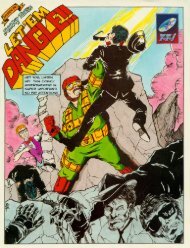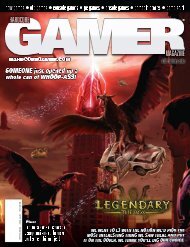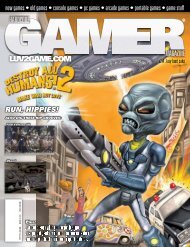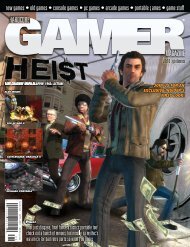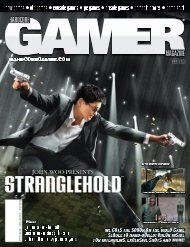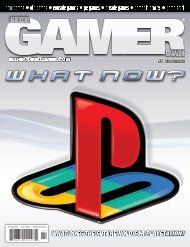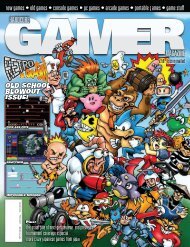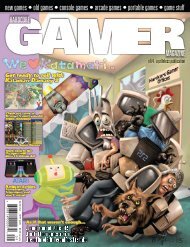You also want an ePaper? Increase the reach of your titles
YUMPU automatically turns print PDFs into web optimized ePapers that Google loves.
the SPECS<br />
Back by popular demand, I’ve once again dug into my collection of console curiosities and have dusted off a personal favorite:<br />
NEC’s ill-fated answer to Nintendo’s Super Famicom, the SuperGrafx.<br />
the CONSOLE<br />
Manufacturer: NEC Availability: Limited<br />
Year Manufactured: 1989 Cost: $150-300<br />
For those of you who may not recall the console wars of the late ‘80s, allow me to regale you with<br />
a quick video game history lesson. In the US, it was all about the SEGA Genesis and NEC TurboGrafx<br />
16. At the time, Nintendo’s NES was showing its age and SEGA, having scuttled their 8-bit Master<br />
System in lieu of the 16-bit Genesis, was capturing a huge market share. In Japan, Nintendo’s<br />
powerful 16-bit Super Famicom (thanks to the power of the plumber and some nifty hardware<br />
tricks) came out swinging, giving SEGA a run for their money. Unfortunately, somewhere in the<br />
shuffle, NEC came out on bottom. Having enjoyed a long and prosperous run with their PC Engine<br />
(the Japanese equivalent of the TurboGrafx), they knew that the 8-bit machine’s time was coming<br />
to an end. To compete with Nintendo and SEGA’s 16-bit hardware, NEC went back to the drawing<br />
board and came up with an answer: the SuperGrafx.<br />
Basically an upgraded version of the PC Engine, the SuperGrafx promised 16bit quality graphics<br />
and sound, but more or less failed to deliver on all accounts. Employing a similar chipset to the PC<br />
Engine, the console’s main strength was that it had much more RAM allocated for its main CPU and<br />
a second video chip with its own video RAM. Some of the nifty graphical tricks it could do included<br />
parallax scrolling and the ability to have tons of sprites on-screen simultaneously without flicker or<br />
slowdown. It also held the distinction of being backward compatible with the PC Engine and could<br />
play pretty much the gamut of PC Engine HuCards and CDs (the latter with the addition of the<br />
separately sold RAU-30 adapter). On the downside, the system used the same 8-bit sound chip as<br />
the PC Engine, which resulted in sub-par music and sound effects that just couldn’t compete with<br />
the likes of SEGA and Nintendo’s hardware.<br />
The SuperGrafx still looks like a modern piece of hardware, with its grey-colored plastic casing,<br />
unique rivet design and blue stencil logo proudly emblazoned on the top of the console. It has<br />
one port for a game pad, and a slot for HuCards located on top of the system. Expansion ports on<br />
the front and back were for extra add-ons (such as the RAU-30 CD adapter), as well as a special<br />
“controller” called the Power Console: a huge peripheral that was to slide over the SuperGrafx and<br />
featured a flight yoke, throttle and keypad (much like Capcom’s Steel Battalion controller for the<br />
Xbox). Unfortunately, this monster controller never surfaced at retail and only exists in prototype<br />
format.<br />
The SuperGrafx’s major downfall was that there were only five true SG games produced for the<br />
system, and most were disappointing at that. Oddly enough, the system, which used to be rare and<br />
hard to find, has become commonplace on auction sites such as eBay, with prices to match. The<br />
games, however, can be tough to find and fetch prices upwards of $100 per title.<br />
CPU: 8-bit HuC6280A with a modified 65C02 chipset running at either 3.58 or 7.16 MHz<br />
GPU: One 16-bit HuC6260 VCE (Video Color Encoder), two 16bit HuC6260A VDCs (Video<br />
Display Controllers) and a HuC6202 VPC (Video Priority Controller)<br />
Display Resolution: 256x224<br />
Colors: 512 available with 481 on-screen<br />
Memory: Work RAM = 32KB, Video RAM = 128KB<br />
Audio: 6 PSG audio channels using the HuC6280A CPU.<br />
28_FEATURE_CONSOLE CURIOSITIES: SUPERGRAFX HARDCORE GAMER MAGAZINE_VOLUME 1_ISSUE 9_WARM BUN




